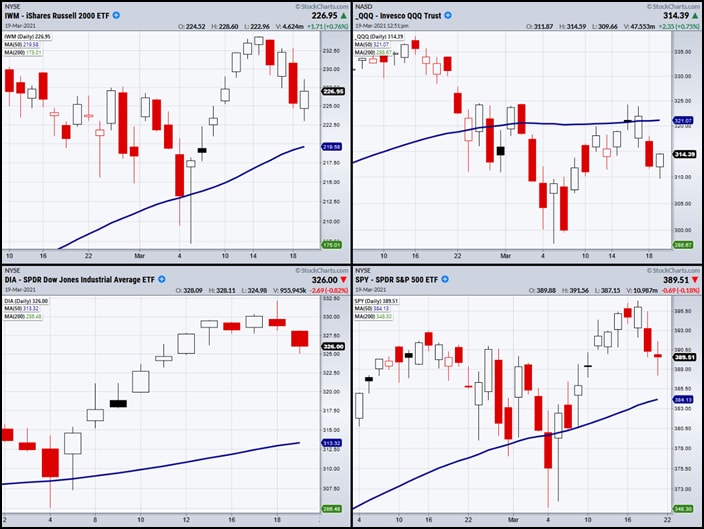In this article, Mish Schneider, director of trading research and education at MarketGauge.com, considers in what situations it is sometimes best to take a step back.
When to trade and when to do nothing…
The easy answer to the question of when to trade is if you do not know what to do, you should probably do nothing.
But, it gets more complicated if you do not know why you should be doing nothing.
No one likes to feel as though they are missing out on profits by not participating.
With that in mind, here is a way you can look at the major indices and come up with a clear plan of action.

The above daily charts are of the four major indices including the Russell 2000 Index (represented by the iShares Russell 2000 ETF [IWM]), the S&P 500 (represented by the SPDR S&P 500 Trust ETF [SPY]), the Nasdaq 100 (represented by the Invesco QQQ ETF [QQQ]) and the Dow Jones (represented by the SPDR Dow Jones Industrial Average ETF [DIA]).
Simply put, we are trying to figure out what each index is doing and if they are moving together or not.
A movement in unison makes it easy to discern the path of least resistance.
If they are not moving together this is equally important as it shows us that the market is confused or choppy.
Currently, the SPY and IWM dailies are pulling back towards support of their 50-day moving averages (DMAs).
The DIA, while stronger than the rest, has also pulled back.
Because the DIA is far from its 50-DMA, it would make more sense to watch its nearest support area around $320.
On the other hand, we have the QQQ, which tested the resistance from its 50-DMA and failed to stay over.
One important thing to note is that all the indices’ moving averages are sloping upwards and three of the four are in bullish phases —when the price is over the 50-DMA and the 50-DMA is over the 200-DMA.
Both reasons keep our current market stance bullish.
To boil all this down, we have three indices moving together on a pullback with the fourth — QQQ — recently failing a pivotal point.
We have also seen some choppy price action, as both IWM and SPY have flipped back and forth between green and red days last week.
Through Monday, we will keep a bullish bias but also know the pullback could continue.
If the market moves lower, we will watch how the indices behave when they approach their support area.
If the indices rally back up instead, we will watch how the QQQ performs near the resistance of the 50-DMA and if the other three are moving upwards together.
Because of the choppy conditions, if we decide to take any trades, we can reduce our normal trading size and therefore reduce our amount of risk and exposure to the market.
With that said, if the indices continue to have divergence, having patience and doing nothing is never a bad choice.
This article was originally published on MarketGauge. With over 100 years of combined market experience, MarketGauge's experts provide strategic information to help you achieve your investing goals.
Continue reading for FREE
- Includes free newsletter updates, unsubscribe anytime. Privacy policy



